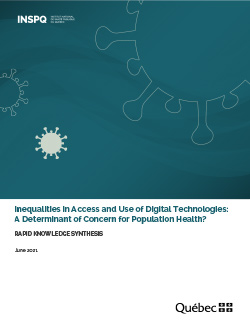Inequalities in Access and Use of Digital Technologies: A Determinant of Concern for Population Health?
Digital technologies have proven essential during the COVID-19 pandemic for jobs and education and to provide access to a range of online activities and services. While the screen time of many Quebecers has increased in this context, inequalities in access and use have been reported. Based on a quick synthesis of the knowledge, the objectives of this publication are to document the digital inequalities faced by populations in economically vulnerable situations, people living in regions that are underserved or poorly served by telecommunications services, senior populations, school-age populations, and populations with low literacy levels. Measures are proposed to mitigate these inequalities with a view to ensuring equitable access to a range of services, information, and services and activities related to a number of determinants of health.
Key messages
The literature consulted reveals the following findings:
- Income is the factor with the highest impact on access to the Internet. Populations in economically vulnerable situations with limited access to digital technologies have been more negatively impacted by the health measures applied to workplace and educational conditions.
- The lack of infrastructure providing access to a fast, reliable, and affordable Internet network contributes to digital inequalities. Populations who are underserved or poorly served by telecommunications services risk being denied optimal access to work, education, and healthcare and social services, especially when residing far from healthcare establishments.
- Digital technologies help break the isolation of populations of seniors who live alone, but their use is often impeded by a lack of access to and familiarity with these technologies. Social support and assistance in the progressive application of new skills may promote the digital inclusion of these populations.
- The quality of access and beneficial use of digital technologies for children’s online education is largely conditional on the material resources, support, and supervision provided in family and school environments. Parents and teachers do not always have adequate support to face the challenges of online education.
- There are a number of types of literacy at play within digital inequalities (e.g., traditional literacy, health literacy, science literacy, media literacy). The use of digital technologies by populations with low literacy levels offers fewer benefits, and even involves more risks to their health than that of populations with a higher literacy level.
The documented measures targeting equitable access to digital technologies are:
- Adopting government policies guaranteeing universal or equitable access to digital technologies.
- Supporting the digital shift in public institutions
(e.g., schools, libraries, municipal buildings and parks, hospital centres and CHSLDs).
The documented measures that aim for equitable digital technology use are:
- Setting up tech support to help people make proper use of digital technologies in a way that is cost-effective.
- Providing opportunities for learning and mutual support to help develop general digital skills as well as those specific to health.
- Creating environments that foster online learning to support schooling from home when necessary.
- Involving different population groups in developing spaces and digital resources specifically for them in order to customize the services and tools to their needs and inform designers on the adoption of universal design concepts.
- Ensuring that a range of high-quality offline alternatives and substitutes for online services are available to compensate for digital inequality and to accommodate communication preferences.
- Encouraging organizations to invest in digital literacy and eHealth with emphasis on equity, including through their online service offering, training, monitoring disparities in access, and evaluating the results.
Despite the many advantages provided by access to and use of digital technologies in a pandemic context, it is important to remember that intensive screen use is not without health risks.
It is important to create conditions conducive to reasonable use of digital technologies that does not harm the development of individuals or health of the population.


